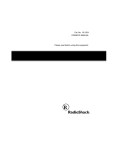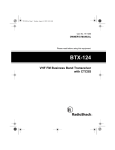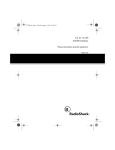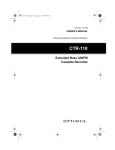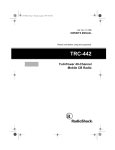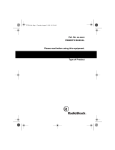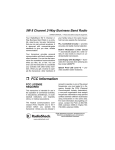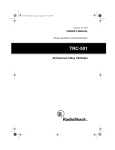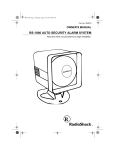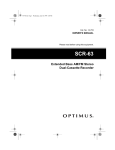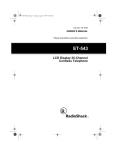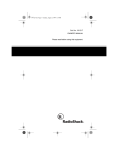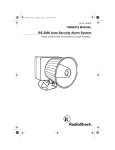Download Radio Shack BTX-123 Owner`s manual
Transcript
19-1204.fm Page 1 Tuesday, August 3, 1999 10:18 AM Cat. No. 19-1204 OWNER’S MANUAL Please read before using this equipment. BTX-123 Business Band Transceiver 19-1204.fm Page 2 Tuesday, August 3, 1999 10:18 AM FEATURES Your RadioShack BTX-123 Business Band Transceiver is a portable, two-way business radio service transceiver that you can carry almost anywhere. The crystal-controlled circuitry provides accurate and stable channel selection. The transceiver is compact and light, making it an ideal choice for your business needs. Your transceiver has the following features: Factory-Installed Crystals — let you begin using your transceiver on 154.600 MHz as soon as you receive your license. Two-Channel Operation — lets you install optional crystals so you can operate your transceiver on another frequency. Adjustable Squelch — helps eliminate noise between transmissions. RF Power Switch — lets you set your transceiver’s output power level to high (for increased range) or low (to save battery power). riety of voice levels to ensure an understandable transmission. 3-Color Receive/Transmit/Battery Low Indicator — lights green when you receive transmissions, red when you send transmissions, and yellow when the battery is low. Battery Charger — lets you recharge the transceiver’s battery pack while the battery pack is connected to or removed from the transceiver. Flexible Antenna with BNC Connector — provides excellent reception. The BNC connector is designed so you can easily attach and remove the supplied antenna or an optional one. Belt Clip — lets you attach the transceiver to your belt or waistband. We recommend you record your transceiver’s serial number here. This number is on the transceiver’s back panel. Serial Number_________________ Built-In Modulation Limiter Circuit — automatically adjusts for a wide va© 1997 Tandy Corporation. All Rights Reserved. RadioShack is a registered trademark used by Tandy Corporation. 2 19-1204.fm Page 3 Tuesday, August 3, 1999 10:18 AM CONTENTS FCC Regulations .............................................................................................. FCC License Required .............................................................................. FCC Part 90 Rules .................................................................................... Additional FCC Regulations ...................................................................... 4 4 5 6 Preparation ....................................................................................................... 7 Powering the Transceiver .......................................................................... 7 Installing/Removing the Battery Pack ................................................. 7 Charging the Battery Pack .................................................................. 7 Connecting the Antenna ............................................................................ 8 Connecting an Optional Antenna ........................................................ 9 Connecting an Earphone or Headphones ................................................. 9 Listening Safely ................................................................................. 10 Traffic Safety ..................................................................................... 10 Connecting an Extension Speaker .......................................................... 10 Using the Belt Clip ................................................................................... 10 Using an External Speaker/Microphone ................................................... 11 Changing or Adding Crystals .................................................................... 11 Ordering Crystals .............................................................................. 13 Operation ....................................................................................................... Receiving Transmissions and Adjusting Squelch .................................... Transmitting ............................................................................................. Operational Hints ..................................................................................... 14 14 15 16 Troubleshooting ............................................................................................. 17 Care and Maintenance ................................................................................... 18 Specifications ................................................................................................. 19 3 19-1204.fm Page 4 Tuesday, August 3, 1999 10:18 AM FCC Regulations This transceiver is intended for use in the operation of commercial activities, educational, philanthropic, or ecclesiastical institutions, and hospitals, clinics, or medical associations. Warning: Do not open your transceiver to make any internal adjustments except changing or installing new crystals. Any other internal adjustments can lead to illegal operation as defined by Part 90 of FCC Rules. Such illegal operation can lead to fines or confiscation of equipment. • Apply for a frequency through the PCIA unless you are already qualified to operate on the supplied frequency. The PCIA is a non-profit organization that assigns frequencies nationwide to help prevent conflicts between different businesses using transceivers in the same area. FCC License Required For more information about getting a license, contact the PCIA at 800759-0300, extension 3068 (in Virginia 703-739-0300, extension 3068). For other questions concerning the license application, contact the FCC at 717-337-1212, or write: Before you operate the transceiver, the FCC (Federal Communications Commission) requires that you: FCC P.O. Box 1040 Gettysburg, PA 17325 • Obtain a license, which you can get by submitting a completed FCC Form 600 to the FCC (or through the PCIA (Personal Communication Industry Association) if you do not already qualify for the supplied frequency). • Understand Part 90 of the FCC Rules and Regulations. It is the user’s responsibility to see that this unit is operating at all times in accordance with the FCC Rules and Regulations. 4 For the latest FCC application form and instructions, call the FCC’s faxon-demand service at 1-202-4180177, provide the number of a fax machine where you can receive documents, and request one or more of the following documents: All forms and instructions Form 600 instructions only Main Form 600 only Form 600 schedules only 000600 006001 006002 006003 19-1204.fm Page 5 Tuesday, August 3, 1999 10:18 AM If you do not have access to a fax machine, you can call the Government Forms Distribution Center at 1-800-418-FORM and request that the form and instructions be mailed to you. FCC Part 90 Rules You must be familiar with Part 90 of FCC Rules before you operate your transceiver. The operation instructions in this manual conform to Part 90, but do not cover all items in Part 90. Overall, Part 90 states that: • You must have a valid license before you use the transceiver. • As licensee, you are responsible for proper operation of all transceivers operating under your license authority. • You can let unlicensed persons operate this transmitter, as long as you take precautions to prevent unauthorized transmissions. • You must use this transceiver only for the commercial use of your business, and only when other commercial channels (such as the telephone) are either not available or not practical. • You must always yield the operating frequency to communications that involve the safety of life or property. • You must take reasonable precautions to prevent harmful interference to other services operating on the same frequency. • You must not transmit program material of any kind used in connection with commercial broadcasting. • You must not provide a service that is normally handled by telephone or telegraph unless such broadcasts involve the safety of life or property or in emergencies such as an earthquake, hurricane, flood or a similar disaster where normal communication channels are disrupted. • During each transmission or exchange of transmissions, you must identify your station with the call sign issued to you by the FCC, or once each 15 minutes during periods of continuous operation. 5 19-1204.fm Page 6 Tuesday, August 3, 1999 10:18 AM • You must keep a written record of any maintenance or modification made to the transceiver, and you must make this record available for inspection upon demand by the FCC. Violating any of the provisions of Part 90 can result in fines and/or confiscation of equipment. ADDITIONAL FCC REGULATIONS The Business Radio Service is under the jurisdiction of the Federal Communications Commission (FCC). Any adjustments or alterations that would alter the performance of the transceiver so it no longer meets the original FCC type acceptance or would change the frequency-determining method are strictly prohibited. Replacement or substitution of crystals, transistors, ICs, regulator diodes, or any other component that is of a unique nature with components other than those recommended can violate the technical regulations of the FCC rules or violate type acceptance requirement of the rules. 6 Your transceiver might cause TV or radio interference even when it is operating properly. To determine whether your transceiver is causing the interference, turn off your transceiver. If the interference goes away, your transceiver is causing it. Try to eliminate the interference by: • Moving your transceiver away from the receiver • Contacting your local dioShack store for help Ra- 19-1204.fm Page 7 Tuesday, August 3, 1999 10:18 AM PreparATION Powering the Transceiver Charging the Battery Pack You power your transceiver using the supplied rechargeable battery pack. You must charge the battery pack before you use it (see “Charging the Battery Pack”). You must charge the battery pack using the supplied AC adapter. It takes about 14–16 hours to recharge a battery pack that is fully discharged. You can charge the battery pack while it is installed or removed. Installing/Removing the Battery Pack To install the battery pack, slide it onto the transceiver as shown. Caution: The battery pack fits onto the transceiver only one way. Do not force it. To remove the battery pack, slide and hold up RELEASE on the side of the transceiver in the direction of the arrow and slide the pack off. Cautions: • Do not use the transceiver while you are charging the battery pack. This might damage the transceiver, the AC adapter, or the battery pack. • The supplied adapter supplies 12 volts and delivers at least 100 milliamps. Its center tip is set to positive, and its barrel plug correctly fits the battery pack’s CHRG jack. Using an adapter that does not meet these specifications could damage the transceiver or the adapter. • Never use any other charger to recharge the battery pack. This could permanently damage your transceiver or the battery pack. • When you finish using the AC adapter, disconnect it from the AC outlet first. Then disconnect it from the transceiver. 7 19-1204.fm Page 8 Tuesday, August 3, 1999 10:18 AM Follow these steps to charge the battery pack. 1. If the battery pack is attached to the transceiver and the transceiver is on, turn it off. 2. Plug the adapter’s barrel plug into the CHRG jack on the side of the battery pack. Then plug the adapter’s power module into a standard AC outlet. Important! At the end of a rechargeable battery pack’s useful life, it must be recycled or disposed of properly. Contact your local, county, or state hazardous waste management authorities for information on recycling or disposal programs in your area. Some options that might be available are: municipal curb-side collection, drop-off boxes at retailers such as your local RadioShack store, recycling collection centers, and mailback programs. Connecting THE Antenna Caution: To prevent damage to your transceiver, you must connect an antenna before you operate it. Follow these steps to attach the supplied flexible antenna to your transceiver. Warning: Do not use an AC adapter’s polarized plug with an extension cord, receptacle, or other outlet unless the blades can be fully inserted to prevent blade exposure. Note: A rechargeable battery pack lasts longer and delivers more power if you let it fully discharge once a month. To do this, simply use the transceiver until the BUSY/TX/BATT indicator on the front of the transceiver lights yellow when you press PUSH TO TALK. Then fully charge the battery pack. 8 19-1204.fm Page 9 Tuesday, August 3, 1999 10:18 AM 1. Align the slots around the antenna’s connector with the tabs on the antenna jack on top of the transceiver. 2. Press the antenna down over the jack and turn the antenna’s base clockwise until it locks into place. To remove the antenna, turn the antenna’s base counterclockwise until it unlocks, then lift it off the antenna jack. Connecting an Optional Antenna The transceiver’s antenna jack makes it easy to use the transceiver with a variety of antennas. Instead of the supplied antenna, you can attach a different one, such as an external mobile antenna or outdoor base station antenna. Your local RadioShack store sells a variety of antennas. Follow the installation instructions supplied with the antenna, route the antenna cable to the transceiver, then connect it to the antenna jack. Warning: Use extreme caution when installing or removing an outdoor antenna. If the antenna starts to fall, let it go! It could contact overhead power lines. If the antenna touches a power line, contact with the antenna, mast, cable or guy wires can cause electrocution and death! Call the power company to remove the antenna. Do not attempt to do so yourself. CONNECTING an Earphone OR HEADPHONES For private listening, pull up the attached plug then connect an optional earphone or mono headphones with 1 a /8-inch plug (available at your local RadioShack store) to the EAR jack on top of your transceiver, This disconnects the internal speaker. Always use 50-ohm coaxial cable, such as RG-58 or RG-8, to connect an outdoor antenna. For lengths over 50 feet, use RG-8 low-loss dielectric coaxial cable. If your antenna’s cable does not have a BNC connector, you will also need a BNC adapter (available at your local RadioShack store). 9 19-1204.fm Page 10 Tuesday, August 3, 1999 10:18 AM Listening Safely To protect your hearing, follow these guidelines when you use an earphone or headphones: • Do not listen at extremely high volume levels. Extended highvolume listening can lead to permanent hearing loss. • Set the volume to the lowest setting before you begin listening. After you begin listening, adjust the volume to a comfortable level. • Once you set the volume, do not increase it. Over time, your ears adapt to the volume level, so a volume level that does not cause discomfort might still damage your hearing. side sounds when listening at normal volume levels, they still can present a traffic hazard. Connecting an Extension Speaker In a noisy area, an extension speaker or an amplified speaker might provide more comfortable listening. You can find a selection of speakers at your local RadioShack store. Pull up the attached plug then plug the speaker cable’s 1/8-inch plug into your transceiver’s EAR jack. This disconnects the internal speaker. Traffic Safety Do not use an earphone or headphones with your transceiver when operating a motor vehicle or riding a bicycle in or near traffic. Doing so can create a traffic hazard and could be illegal in some areas. If you use an earphone or headphones with your transceiver while riding a bicycle, be very careful. Do not listen to a continuous broadcast. Even though some earphones/ headphones let you hear some out10 Using the Belt Clip You can attach the supplied belt clip to the transceiver for hands-free carrying when you are on the go. 19-1204.fm Page 11 Tuesday, August 3, 1999 10:18 AM Use a Phillips screwdriver to attach the belt clip to the back of the transceiver with the two supplied screws and washers. Then slide the belt clip over your belt or waistband. CHANGING OR ADDING Crystals Your transceiver comes with a pair of crystals installed in Channel A for operation on 154.600 MHz. You can order crystals from your local RadioShack store for Channel B or as replacements for Channel A. Be sure to specify the transceiver’s catalog number — 19-1204. Important: Channel A crystals are soldered in, and can only be replaced by a qualified technician. Using an External SPEAKER/ Microphone To connect an external speaker/microphone (such as Cat. No. 19-312 or 19-314) to the transceiver, pull up the attached plug then plug the 3/32-inch speaker/microphone’s plug into the transceiver’s MIC jack and its 1/8-inch plug into the transceiver’s EAR jack. This disconnects the transceiver’s speaker. You must request a frequency assignment from the PCIA before ordering crystals. Call the PCIA at 800759-0300, extension 3068 (in VA, call 703-739-0300, extension 3068). They will advise you of the required information as well as the current fees. Then send your FCC Form 600 to the PCIA. They will assign a frequency and forward the application to the FCC. Your transceiver can operate from 152.255 to 156.250 MHz on any of the business radio frequencies authorized by the FCC. To determine the crystals you need to order, use the formulas under “Ordering Crystals” on Page 13. You can order the crystals through your local RadioShack store. 11 19-1204.fm Page 12 Tuesday, August 3, 1999 10:18 AM Follow these steps to install crystals. 1. Remove the battery pack and the antenna. 2. Use a Phillips screwdriver to remove two of the screws on the battery guide plate as shown. Then loosen the other two screws on the battery guide plate about 4 full turns. (This makes it easier to reinstall the back cover later). Note: You do not need to loosen or remove the battery contact plate’s two screws. and its spring, place your hand over PUSH TO TALK while removing the back cover. 4. Use a Phillips screwdriver to remove all four screws from the transceiver’s back cover. Then, while holding PUSH TO TALK with one hand, carefully remove the back cover. 5. Install or replace the new crystals in the sockets. Be sure to install the receive and transmit crystals in the correct sockets as shown. 3. Pull up the rubber plug covering the MIC and EAR jacks to expose both jacks. Caution: PUSH TO TALK on the side of the transceiver is under spring tension, and it might come loose when you remove the back cover in the next step. To avoid losing PUSH TO TALK 12 6. Replace the back cover and secure it with the four screws. 19-1204.fm Page 13 Tuesday, August 3, 1999 10:18 AM 7. Replace the two screws you removed from the battery guide plate, then tighten all the screws. 8. Replace the battery pack and the antenna. We recommend you only order crystals for this transceiver through your local RadioShack store. If you do purchase them from another source, the following information might be helpful: • Case Type: HC-50/T Ordering Crystals • Load Capacitance: 20 pF To determine the crystals you need, use the following formulas: Transmit Crystal: Operating Frequency 8 Receive Crystal: Operating Frequency — 10.7 (MHz) 4 For example, to transmit and receive on 151.455 MHz, specify a transmit crystal of 18.931875 (151.455 MHz/8) and a receive crystal of 35.18875 MHz ( (151.455 – 10.7 MHz)/4). 13 19-1204.fm Page 14 Tuesday, August 3, 1999 10:18 AM OPERATION RECEIVING TRANSMISSIONS AND ADJUSTING SQUELCH Note: Make sure the transceiver’s antenna is connected before you turn it on. 1. Turn SQUELCH fully counterclockwise. Notes: • The BUSY/TX/BATT indicator on the front of the transceiver lights green when the transceiver receives a transmission. • If the transceiver picks up unwanted, partial, or very weak transmissions, turn SQUELCH clockwise to decrease the transceiver’s sensitivity to these signals. If you want to listen to a weak or distant station, turn SQUELCH counterclockwise. 4. Set CHANNEL to A or B. 2. Turn on the transceiver by turning VOLUME clockwise until you hear a click and a hissing sound. 3. Turn SQUELCH clockwise until the hissing sound stops. 14 Note: Your transceiver comes with crystals installed in channel Position A. To use other frequencies, you must first install crystals in channel position B inside the transceiver (see “Changing or Adding Crystals” on Page 11). 19-1204.fm Page 15 Tuesday, August 3, 1999 10:18 AM 5. If you are using the supplied antenna, hold the transceiver so the antenna is vertical. 6. Adjust VOLUME to a comfortable listening level. 7. To conserve battery power, set RF POWER to LO. Or, if the person you are transmitting to has trouble receiving your signal, set RF POWER to HI. The BUSY/TX/BATT indicator on the front of the transceiver lights red when you press PUSH TO TALK. 3. When you finish release the button. speaking, 4. To turn off the transceiver, turn VOLUME toward OFF until it clicks. 8. To turn off the transceiver, turn VOLUME toward OFF until it clicks. Transmitting 1. Follow Steps 1–7 in “Receiving Transmissions and Adjusting Squelch” on Page 14. 2. Hold the transceiver 2–3 inches from your mouth. Hold down PUSH TO TALK and speak into the microphone on the front of the transceiver in a normal voice. Notes: • The transceiver’s automatic modulation circuit adjusts the microphone’s sensitivity for a wide variety of voice levels. • Do not speak too loudly when transmitting. It does not make your signal any stronger, and might distort your transmission. • Do not hold down PUSH TO TALK when you are not talking. (This is called dead keying.) 15 19-1204.fm Page 16 Tuesday, August 3, 1999 10:18 AM Operational Hints Your transceiver’s range varies depending on factors such as position, terrain, and battery condition. Buildings absorb transmitted signals and, if they contain metal, might completely block them. Trees and heavy cloud formations have a similar effect, though not as severe. If you are near a lake or the ocean, you might get excellent range. To ensure maximum range, operate the transceiver with the battery pack fully charged. As the voltage decreases, the range decreases. 16 19-1204.fm Page 17 Tuesday, August 3, 1999 10:18 AM TROUBLESHOOTING If your transceiver is not working as it should, these suggestions might help you eliminate the problem. If the transceiver still does not operate properly, take it to your local RadioShack store for assistance. Problem The transceiver does not work at all. Possible Causes Remedies The battery pack is not properly connected. Attach the battery pack to the transceiver (see “Installing/Removing the Battery Pack” on Page 7). The battery pack is not charged. Charge the battery pack (see “Charging the Battery Pack” on Page 7). Be sure the adapter is plugged into a working AC outlet and is fully inserted into the CHRG jack. Poor or no reception. The transceiver does not transmit. Improperly connected an- Be sure the antenna is tenna. properly connected. SQUELCH is not correctly adjusted. Adjust SQUELCH clockwise (see “Receiving Transmissions and Adjusting Squelch” on Page 14). PUSH TO TALK not fully pressed. Fully press PUSH TO TALK. 17 19-1204.fm Page 18 Tuesday, August 3, 1999 10:18 AM CARE AND Maintenance Your RadioShack BTX-123 Business Band Transceiver is an example of superior design and craftsmanship. The following suggestions will help you care for the transceiver so you can enjoy it for years. Keep the transceiver dry. If it gets wet, wipe it dry immediately. Liquids might contain minerals that can corrode the electronic circuits. Handle the transceiver gently and carefully. Dropping it can damage circuit boards and cases and can cause the transceiver to work improperly. Use and store the transceiver only in normal temperature environments. Temperature extremes can shorten the life of electronic devices, damage batteries, and distort or melt plastic parts. Keep the transceiver away from dust and dirt, which can cause premature wear of parts. Wipe the transceiver with a damp cloth occasionally to keep it looking new. Do not use harsh chemicals, cleaning solvents, or strong detergents to clean the transceiver. Modifying or tampering with the transceiver’s internal components can cause a malfunction and might invalidate your transceiver’s warranty and void your FCC authorization to operate it. If your transceiver is not performing as it should, take it to your local RadioShack store for assistance. 18 19-1204.fm Page 19 Tuesday, August 3, 1999 10:18 AM Specifications Transmitter Frequency Coverage ...................................................... 152.255–156.250 MHz Frequency Tolerance ............................................................................ ±1.5 kHz Type of Modulation ........................................................................................ FM RF Power ........................................................................................... 1 W (high) 0.6 W (low) Deviation ................................................................................................. ±5 kHz Spurious Rejection .................................................................................... 45 dB Minimum Operating Voltage .................................................................. 6.5 Volts Current Drain ........................................................... 500 mA (high power mode) Receiver Sensitivity (SINAD 12 dB) ........................................................................ 0.5 µV Signal-to-Noise Ratio (20 dB) ................................................................. . 1.0 µV AF Power Output ................................................................................... 250 mW Adjacent Channel Rejection ...................................................................... 50 dB Squelch Sensitivity (Start) ........................................................................ 0.5 µV Stop Voltage .......................................................................................... 6.5 Volts Distortion (1 mV Input, 3 kHz Deviation) ...................................................... . 5% General Power Requirements ...................................................................... 8.4 Volts DC 7 Antenna Length ................................................................................ 5 /8 Inches (150 mm) 1 1 1 Dimensions (HWD) .................................................... 2 /2 × 1 /2 × 6 /3 Inches (65 × 35 × 160 mm) Weight ..................................................................................................... 15.5 oz (439 g) Specifications are typical; individual units might vary. Specifications are subject to change and improvement without notice. 19 19-1204.fm Page 20 Tuesday, August 3, 1999 10:18 AM Limited Ninety-Day Warranty This product is warranted by RadioShack against manufacturing defects in material and workmanship under normal use for ninety (90) days from the date of purchase from RadioShack company-owned stores and authorized RadioShack franchisees and dealers. EXCEPT AS PROVIDED HEREIN, RadioShack MAKES NO EXPRESS WARRANTIES AND ANY IMPLIED WARRANTIES, INCLUDING THOSE OF MERCHANTABILITY AND FITNESS FOR A PARTICULAR PURPOSE, ARE LIMITED IN DURATION TO THE DURATION OF THE WRITTEN LIMITED WARRANTIES CONTAINED HEREIN. EXCEPT AS PROVIDED HEREIN, RadioShack SHALL HAVE NO LIABILITY OR RESPONSIBILITY TO CUSTOMER OR ANY OTHER PERSON OR ENTITY WITH RESPECT TO ANY LIABILITY, LOSS OR DAMAGE CAUSED DIRECTLY OR INDIRECTLY BY USE OR PERFORMANCE OF THE PRODUCT OR ARISING OUT OF ANY BREACH OF THIS WARRANTY, INCLUDING, BUT NOT LIMITED TO, ANY DAMAGES RESULTING FROM INCONVENIENCE, LOSS OF TIME, DATA, PROPERTY, REVENUE, OR PROFIT OR ANY INDIRECT, SPECIAL, INCIDENTAL, OR CONSEQUENTIAL DAMAGES, EVEN IF RadioShack HAS BEEN ADVISED OF THE POSSIBILITY OF SUCH DAMAGES. Some states do not allow the limitations on how long an implied warranty lasts or the exclusion of incidental or consequential damages, so the above limitations or exclusions may not apply to you. In the event of a product defect during the warranty period, take the RadioShack A Division of Tandy Corporation Fort Worth, Texas 76102 6A7 Printed in Hong Kong




















